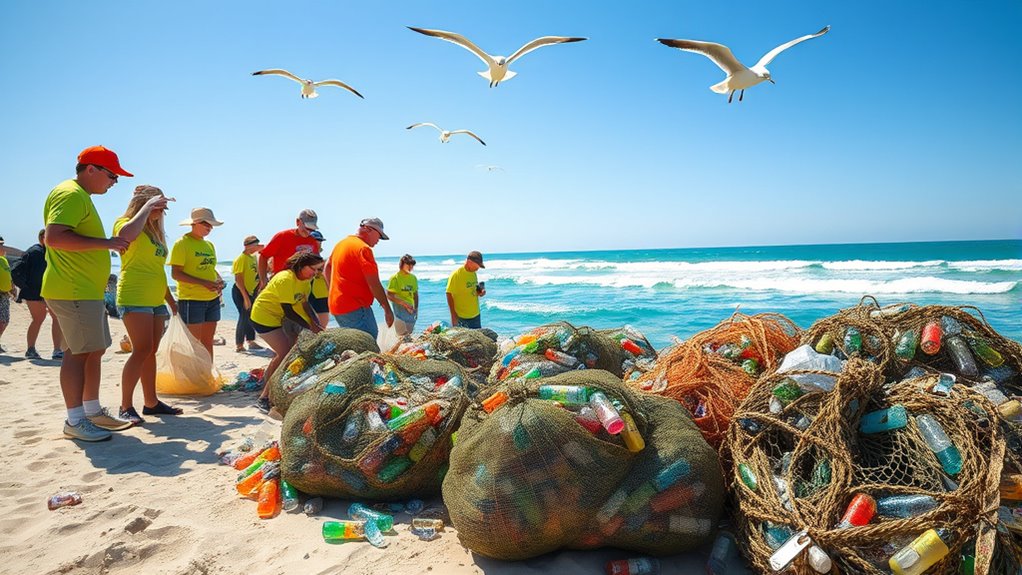To organize a beach clean-up, choose an accessible location and pick a day with good weather, preferably early morning or low tide. Gather supplies like trash bags, gloves, and tools, and recruit volunteers through social media and community groups. Assign roles, guarantee safety measures, and coordinate waste disposal with local authorities. Celebrate your efforts and share the results. If you want to learn more tips to make it a success, keep exploring the details below.
Key Takeaways
- Select accessible, safe beach locations and plan the event during optimal weather and low-traffic times.
- Recruit volunteers via social media, community groups, and local organizations, promoting the event effectively.
- Prepare supplies such as trash bags, gloves, tools, safety gear, and coordinate with authorities for permits.
- Assign roles, brief volunteers on safety protocols, and document the cleanup with photos and reports.
- Coordinate waste disposal with local facilities, sort recyclables, and share results to encourage ongoing community efforts.
Choosing the Right Location and Time

Choosing the right location and time is essential for a successful beach clean-up. You want to pick a spot that’s accessible and visibly impacted by trash, so your efforts make a real difference. Check local beaches, parks, or protected areas with known litter problems. Timing matters too; plan your clean-up during low tide or early mornings when fewer people are around. Avoid weekends or holidays when beaches are crowded, as it’s harder to coordinate and stay safe. Weather conditions are also important—select a day with good weather to encourage participation and prevent health risks. Additionally, selecting a location with vetted products for cleanup supplies can help ensure safety and effectiveness. Using appropriate safety gear like gloves and masks can also protect volunteers from potential hazards. Planning ahead by coordinating with local authorities can help streamline permissions and support. By choosing an ideal location and time, you maximize your impact and ensure a smoother, more effective clean-up session. Being aware of local regulations can also help you avoid issues with authorities and ensure your efforts are compliant and sustainable.
Gathering Supplies and Equipment
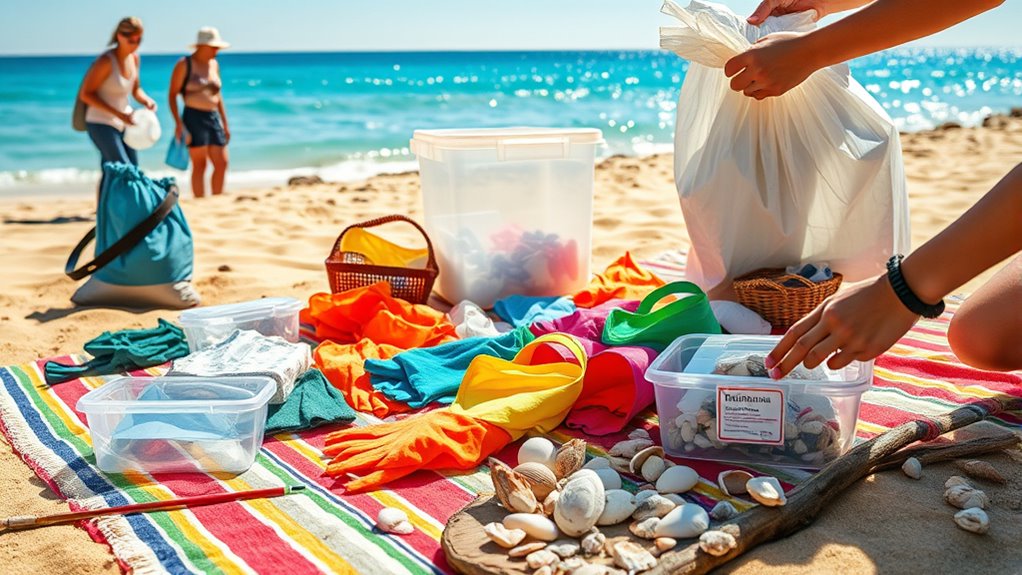
To guarantee your beach clean-up runs smoothly, gathering the right supplies and equipment is essential. First, collect sturdy trash bags or bins to hold debris securely. Bring gloves—preferably heavy-duty and reusable—to protect your hands from sharp objects and contamination. Grab grabbers or tongs to pick up trash without bending down repeatedly. Don’t forget to carry a first aid kit in case of minor injuries. If possible, bring a cooler with water and snacks to keep volunteers energized. Consider having trash pickers, reflective vests for safety, and a camera or phone for photos. Organize supplies beforehand, making sure everything is accessible and in good condition. Proper preparation ensures efficiency and safety throughout your beach clean-up.
Recruiting Volunteers and Promoting the Event
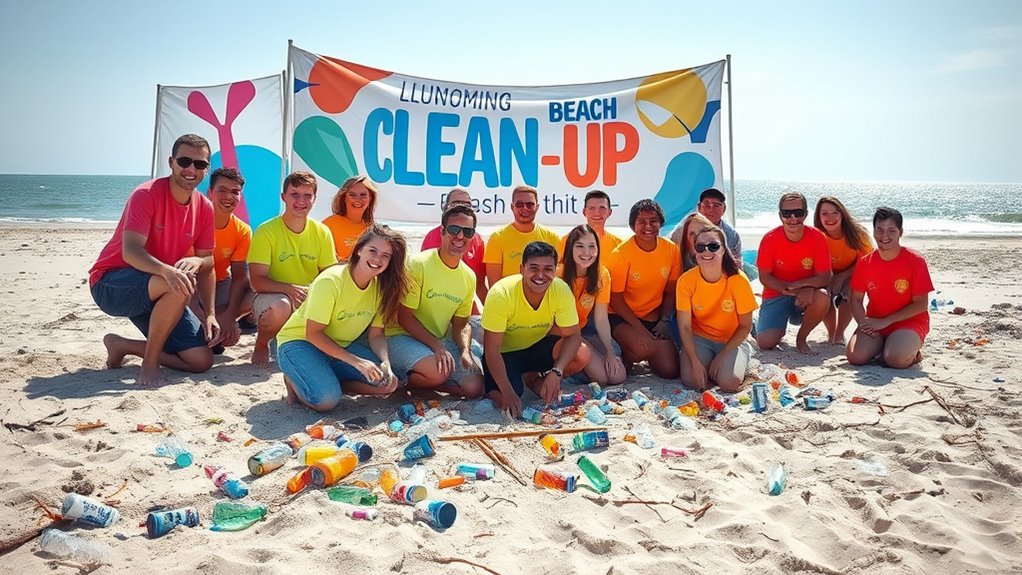
Once you’ve gathered your supplies and outlined the plan, the next step is to recruit volunteers and promote your beach clean-up event. Start by reaching out to friends, family, and community groups through social media, emails, and flyers. Use clear, compelling messages that highlight the event’s purpose and benefits. Partner with local organizations, schools, or businesses to expand your reach and gain support. Encourage volunteers to bring friends or suggest groups to participate. Share details about the date, location, and any incentives, like refreshments or certificates. The more visible and engaging your promotion, the more volunteers you’ll attract. Incorporating effective promotion strategies can significantly increase your outreach and involvement. To foster long-term engagement, consider creating a community involvement plan that keeps volunteers motivated for future events. Additionally, highlighting the positive environmental impact of reducing marine debris can inspire greater participation and commitment to ongoing cleanup efforts. Employing targeted outreach methods can help connect with a broader audience and maximize participation. Building awareness around the importance of environmental sustainability can also motivate volunteers to get involved and stay committed.
Planning the Cleanup Activities and Safety Measures
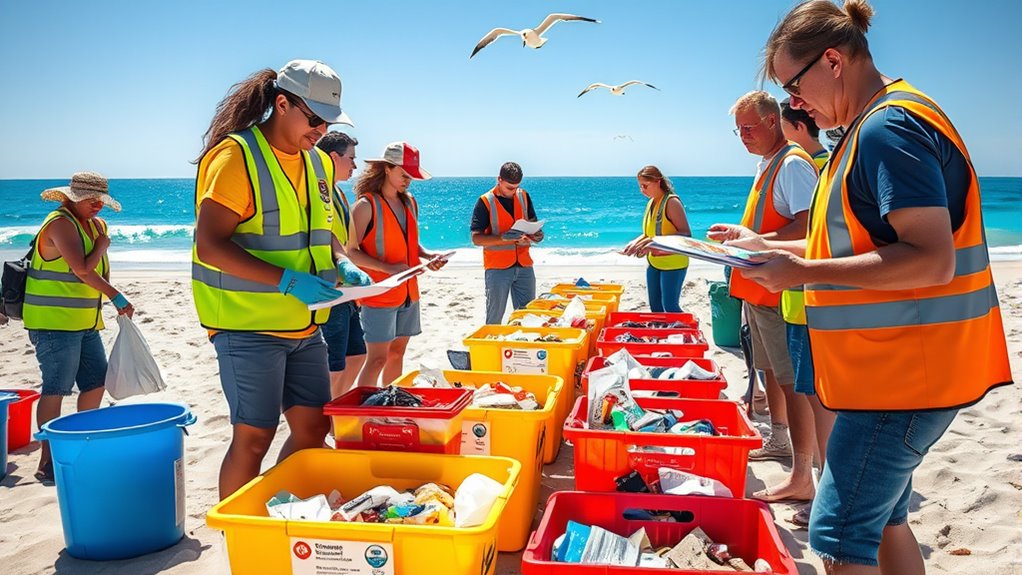
As you plan the cleanup activities, prioritize safety by organizing tasks that match volunteers’ skill levels and providing clear instructions. This approach minimizes accidents and keeps everyone confident. Make sure to assign roles such as trash collectors, safety monitors, and bag handlers. Use a simple table to clarify responsibilities:
| Role | Skills Needed | Safety Tips |
|---|---|---|
| Trash Collectors | Basic physical fitness | Wear gloves, watch for sharp objects |
| Safety Monitors | Observation skills | Keep an eye on volunteers’ safety |
| Bag Handlers | Organization skills | Secure bags properly, avoid overloading |
Clear communication and safety gear are essential. Brief volunteers beforehand and remind them to stay alert and hydrated during the cleanup. Additionally, understanding projector technology can help in planning effective visual safety messages or instructions if needed. Utilizing water park safety standards can also guide your safety measures to ensure a secure environment for all participants.
Coordinating Waste Disposal and Recycling Efforts
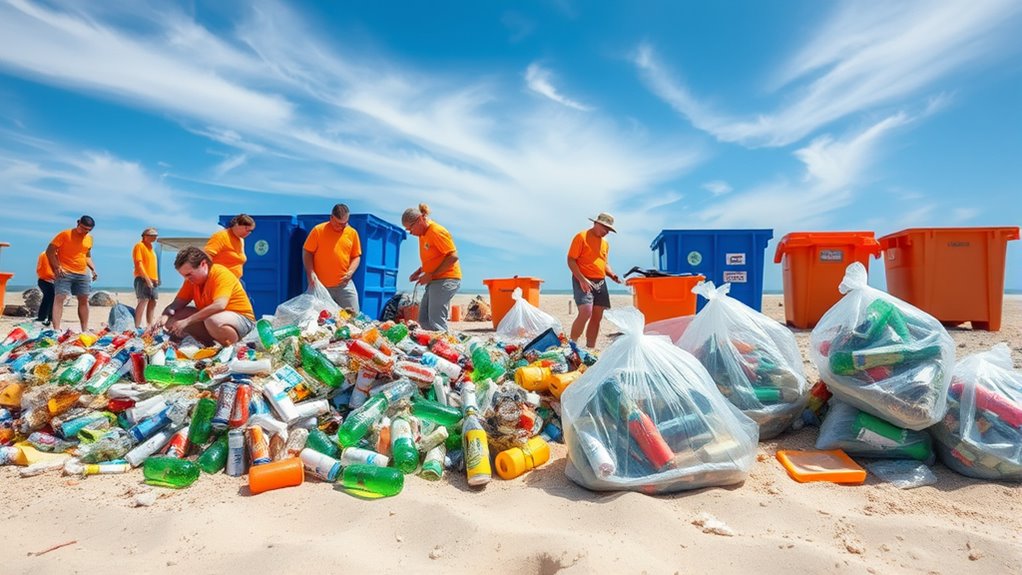
After organizing your cleanup tasks and ensuring volunteers understand safety measures, the next step is to coordinate how the waste collected will be disposed of and recycled. Contact local waste management facilities ahead of time to confirm their procedures and drop-off locations. Arrange for separate bins or bags for recyclables and non-recyclables during the cleanup. Clearly label these containers to avoid confusion. Consider partnering with recycling organizations or charities that can pick up recyclable materials directly from the site. Make sure to transport waste promptly to prevent overflow or environmental hazards. Communicate these plans clearly to your volunteers so everyone knows where to deposit different types of waste. Proper coordination ensures efficient disposal, reduces environmental impact, and supports recycling efforts. Additionally, understanding waste disposal procedures can help optimize the cleanup process and ensure compliance with local regulations. Implementing proper fraud prevention tools in managing donations or sponsorships can also safeguard your event’s funds and reputation. Being aware of the types of waste typically generated during such events can further enhance your planning and disposal efficiency. Incorporating educational components about recycling practices can motivate volunteers to sort waste correctly and promote environmental awareness. Furthermore, reviewing home essentials for eco-friendly options can inspire sustainable choices during cleanup and beyond.
Celebrating Success and Spreading Awareness
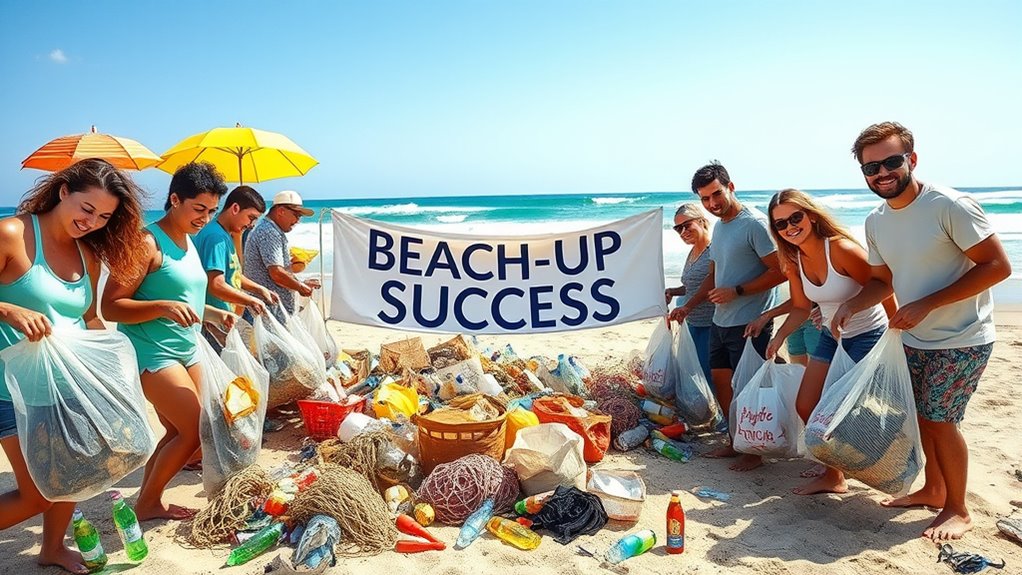
How can you maximize the impact of your beach cleanup? Celebrate your success by sharing stories, photos, and results with your community. Highlight the amount of trash collected and the volunteers who made it happen. Organize a small event or social media campaign to recognize everyone’s effort. Spread awareness by educating others about the importance of keeping beaches clean and protecting marine life. Use this momentum to inspire more people to join future cleanups or adopt eco-friendly habits. Incorporating community engagement strategies can enhance the effectiveness and sustainability of your efforts.
Frequently Asked Questions
How Do I Secure Permits or Permissions for a Beach Cleanup?
To secure permits or permissions for a beach cleanup, start by identifying the local authorities or agencies responsible, such as the city or park department. Reach out to them with your event details, including date, number of participants, and cleanup plans. Be prepared to fill out application forms, pay any fees, and follow specific guidelines. Getting approval ahead of time guarantees your cleanup is legal and runs smoothly.
What Are the Best Ways to Involve Local Schools and Community Groups?
You can involve local schools and community groups by reaching out directly with personalized invitations, highlighting the environmental impact and educational benefits. Collaborate with teachers and group leaders to integrate the event into their programs. Offer fun activities or incentives to encourage participation. Use social media and community boards to spread the word. Building strong relationships and emphasizing the positive community impact will motivate sustained involvement.
How Can I Ensure the Safety of Volunteers During the Cleanup?
To keep volunteers safe, you need to cover all bases before the cleanup begins. Make sure everyone wears gloves, sturdy shoes, and sun protection. Provide a safety briefing to highlight potential hazards like sharp objects or strong currents. Keep first aid kits handy, and assign experienced team members to oversee activities. Remember, safety is no accident—plan ahead and stay alert to avoid any mishaps.
What Eco-Friendly Alternatives Can Be Used for Cleanup Supplies?
You can use eco-friendly alternatives for cleanup supplies by choosing biodegradable trash bags, which break down naturally and reduce plastic waste. Opt for reusable gloves made from sustainable materials like cotton or silicone instead of single-use plastic ones. Consider encouraging volunteers to bring their own reusable containers or tools. Using eco-conscious supplies minimizes environmental impact, keeps the beach cleaner longer, and promotes sustainable habits among participants.
How Can I Measure the Environmental Impact of the Cleanup Effort?
So, you want to measure your beach cleanup’s environmental impact? Well, grab your superhero cape and start by counting how much trash you collect—sounds simple, right? Then, compare your haul to past cleanups or local pollution levels. You can also track improvements in water quality or wildlife sightings over time. It’s like scoring a victory against pollution—by quantifying your heroic deeds!
Conclusion
Remember, many hands make light work. By carefully choosing your location, gathering the right supplies, and rallying volunteers, you’re making a real difference. Keep safety and recycling top priorities, and don’t forget to celebrate your success. Your efforts not only clean the beach but also inspire others to join the cause. Together, you can turn the tide on pollution—because when everyone pitches in, even small actions lead to big change.

